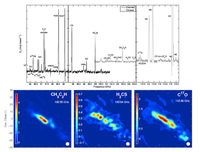Astrochemistry of a Starburst
 Meier et al. present a 50 parsec resolution imaging study of molecular gas species in the central kiloparsec of the nearby starburst galaxy NGC 253 based on ALMA observations. More than 50 emission lines are seen from more than 30 complex molecules emitting at 86 – 115 GHz (ALMA 3mm band). The dramatic variation seen in the HNCO / SiO line ratio suggests that some of the chemical signatures of shocked gas are being erased in the presence of dominating central radiation fields (traced by C2H and CN). High-density molecular gas tracers – including HCN, HCO+, and CN – are detected at the base of the molecular outflow, driven by the starburst.
Meier et al. present a 50 parsec resolution imaging study of molecular gas species in the central kiloparsec of the nearby starburst galaxy NGC 253 based on ALMA observations. More than 50 emission lines are seen from more than 30 complex molecules emitting at 86 – 115 GHz (ALMA 3mm band). The dramatic variation seen in the HNCO / SiO line ratio suggests that some of the chemical signatures of shocked gas are being erased in the presence of dominating central radiation fields (traced by C2H and CN). High-density molecular gas tracers – including HCN, HCO+, and CN – are detected at the base of the molecular outflow, driven by the starburst.
Image: ALMA spectrum and molecular line images of the starburst nucleus of NGC 253
Science Team: David S. Meier (New Mexico Tech, NRAO), Fabian Walter (Max-Planck Institut für Astronomie, NRAO), Alberto D. Bolatto (Maryland), Adam K. Leroy (NRAO), Jürgen Ott (NRAO), Erik Rosolowsky (Univerfity of Alberta), Sylvain Veilleux (University of Maryland), Steven R. Warren (University of Maryland), Axel Weiß (Max-Planck Institut für Astronomie), Martin A. Zwann (ESO), and Laura K. Zschaechner (Max-Planck Institut für Astronomie).
Publication: ALMA Multi-line Imaging of the Nearby Starburst NGC 253, 2015, Astrophysical Journal, 801, 63.




Connect with NRAO